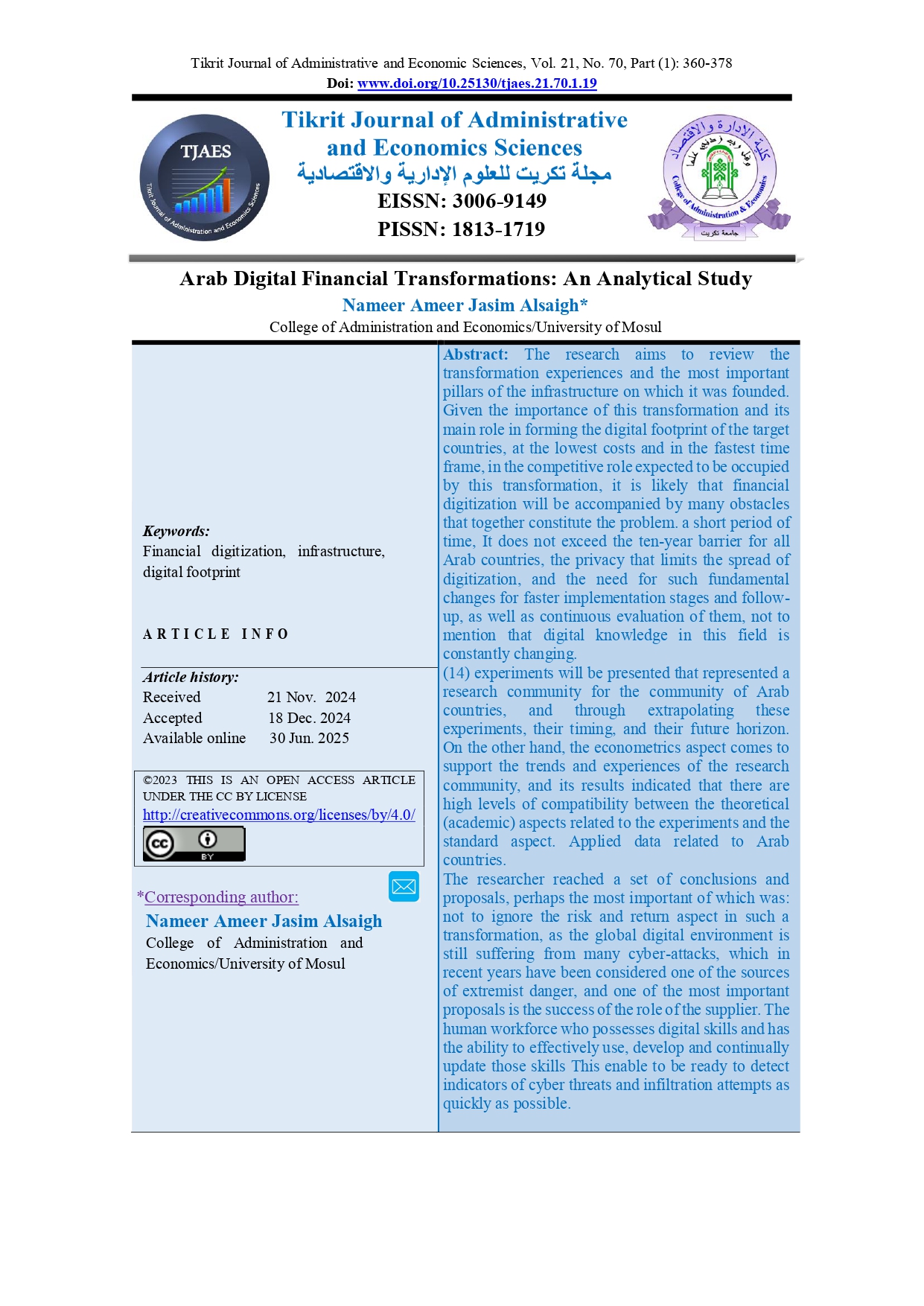Arab Digital Financial Transformations: An Analytical Study
Main Article Content
Abstract
The research aims to review the transformation experiences and the most important pillars of the infrastructure on which it was founded. Given the importance of this transformation and its main role in forming the digital footprint of the target countries, at the lowest costs and in the fastest time frame, in the competitive role expected to be occupied by this transformation, it is likely that financial digitization will be accompanied by many obstacles that together constitute the problem. a short period of time, It does not exceed the ten-year barrier for all Arab countries, the privacy that limits the spread of digitization, and the need for such fundamental changes for faster implementation stages and follow-up, as well as continuous evaluation of them, not to mention that digital knowledge in this field is constantly changing.
(14) experiments will be presented that represented a research community for the community of Arab countries, and through extrapolating these experiments, their timing, and their future horizon. On the other hand, the econometrics aspect comes to support the trends and experiences of the research community, and its results indicated that there are high levels of compatibility between the theoretical (academic) aspects related to the experiments and the standard aspect. Applied data related to Arab countries.
The researcher reached a set of conclusions and proposals, perhaps the most important of which was: not to ignore the risk and return aspect in such a transformation, as the global digital environment is still suffering from many cyber-attacks, which in recent years have been considered one of the sources of extremist danger, and one of the most important proposals is the success of the role of the supplier. The human workforce who possesses digital skills and has the ability to effectively use, develop and continually update those skills This enable to be ready to detect indicators of cyber threats and infiltration attempts as quickly as possible.
Downloads
Article Details
References
اولاً. المصادر العربية:
طلحة الوليد، 2019، دور الهوية الرقميَّة في تعزيز الشمول المالي، أبو ظبي، صندوق النقد العربي، الإِمارات العربية المتحدة.
تقرير صندوق النقد العربي، 2020، المرصد الأَوَّل لتقنيات الماليَّة الحديثة في الدول العربية.
صندوق النقد العربي، استبانة التحولات الرقمية في الدول العربية، 2020، والخطط والاستراتيجيات للتحول نحو الرقمنة المالية في الدول العربية.
عـثمـان، تـوات، 2021، التكنولوجيا المالية كأداة لتعزيز الشمول المالي والتحول الرقمي المصرفي: تجارب ودروس دولية للدول العربية، كلية العلوم الاقتصادية والعلوم التجارية وعلوم الادارة في جامعة الجزائر 3. https://www.researchgate.net/publication/353429925
صندوق النقد العربي، استبانة التحولات الرقمية في الدول العربية، 2020، والخطط والاستراتيجيات للتحول نحو الرقمنة المالية في الدول العربية
الرؤية العربية للاقتصاد الرقمي، الترقيم الدولي ISBN: 978-9948-35-67 جمهورية مصر العربية، القاهرة: المقر الرئيسي الموقع الإِلكتروني: www.arab-digital-economy.org البريد الإِلكتروني: [email protected]
قعلول، سفيان، الوليد، طلحة، 2020، الاقتصاد الرقمي في الدول العربية: الواقع والتحديات. أبو ظبي: صندوق النقد العربي
التقرير السنوي لصندوق النقد العربي، 2018، http://www.amf.org.ae
مصطفى، رديف، 2021، التحول الرقمي كآلية لتعزيز درجة الشمول المالي في الجزائر، مجلة الشرق الأوسط للعلوم الإنسانية والثقافية، المجلد 01، العدد 05، جامعة جيلا اليابس، ريدي بلعباس، الجزائر.
الجمهورية اللبنانية، مكتب وزير الدولة لشؤون التنمية الإدارية"، "استراتيجية التحول الرقمي في لبنان 2020
9- ESCWA مقترح استراتيجية التحول الرقمي الحكومي في دولة ليبيا، كانون الاول، 2022، الهيئة العامة للمعلومات
جامعة الدول العربية،الرؤية الاستراتيجية العربية المشتركة للاقتصاد الرقمي 2019
جمهورية العراق، 2020، "الاستراتيجية الوطنية للأمن السيبراني"، مستشارية الامن الوطني، اللجنة الفنية العليا لأمن الاتصالات والمعلومات
الجمهورية التونسية، 2020، وزارة تكنولوجيا الاتصال والتحول الرقمي.
https://www.mtcen.gov.tn/index.php?id=132&L=1
المملكة العربية السعودية (2020، 8) وزارة الصحة، الخدمات الالكترونية).
الإسكوا، 2018 آفاق الاقتصاد الرقمي في المنطقة العربية. بيروت: الأمم المتحدة.
يوسف، نوران،2021، مؤشر التقنيات المالية الحديثة في الدول العربية (FinxAr) (المنهجية والنتائج) صندوق النقد العربي.
ثانياً. المصادر الأجنبية:
Ayyagari. (2018, November). How important is the digital transformation of financial services in enhancing financial inclusion? Consulté le August 3, 2020, sur www.findevgateway.org: https://www.findevgateway.org/en/interview/2018/11
Abdel momen, H. (2019). Using Blockchain in Financial Services. Abu Dhabi: Arab
3-IMF. (2017). Regional economic outlook. Middle East and Central Asia Washington, DC: International Monetary Fund.
OECD, Financial literacy and inclusion: Results of OCED/INFE survey, 2017 across countries and by gender.
AMF. (2019). Uses of Block chain Technology in Payments Operations: Prospects and Opportunities, Abu Dh9abi.: Arab Monetary Fund ia, H. (2020). Financial Inclusion in the technology-led globalization age. Abu Dhabi: Arab Monetary Fund
World Bank Group, Digital financial services, April 2019
Mitchell, B., & Alfuraih, A. (2018). The Kingdom of Saudi Arabia: Achieving the aspirations of the National Transformation Program 2020 and Saudi vision 2030 through education. Journal of Education and Development, 2(3),
https://www.gsma.com/mobile-money-metrics/#regulatory-index?y=2021& https://www.gpfi.org/data.& https://www.gpfi.org/news/new-g20-high-level-principles-digital-financial-inclusion


